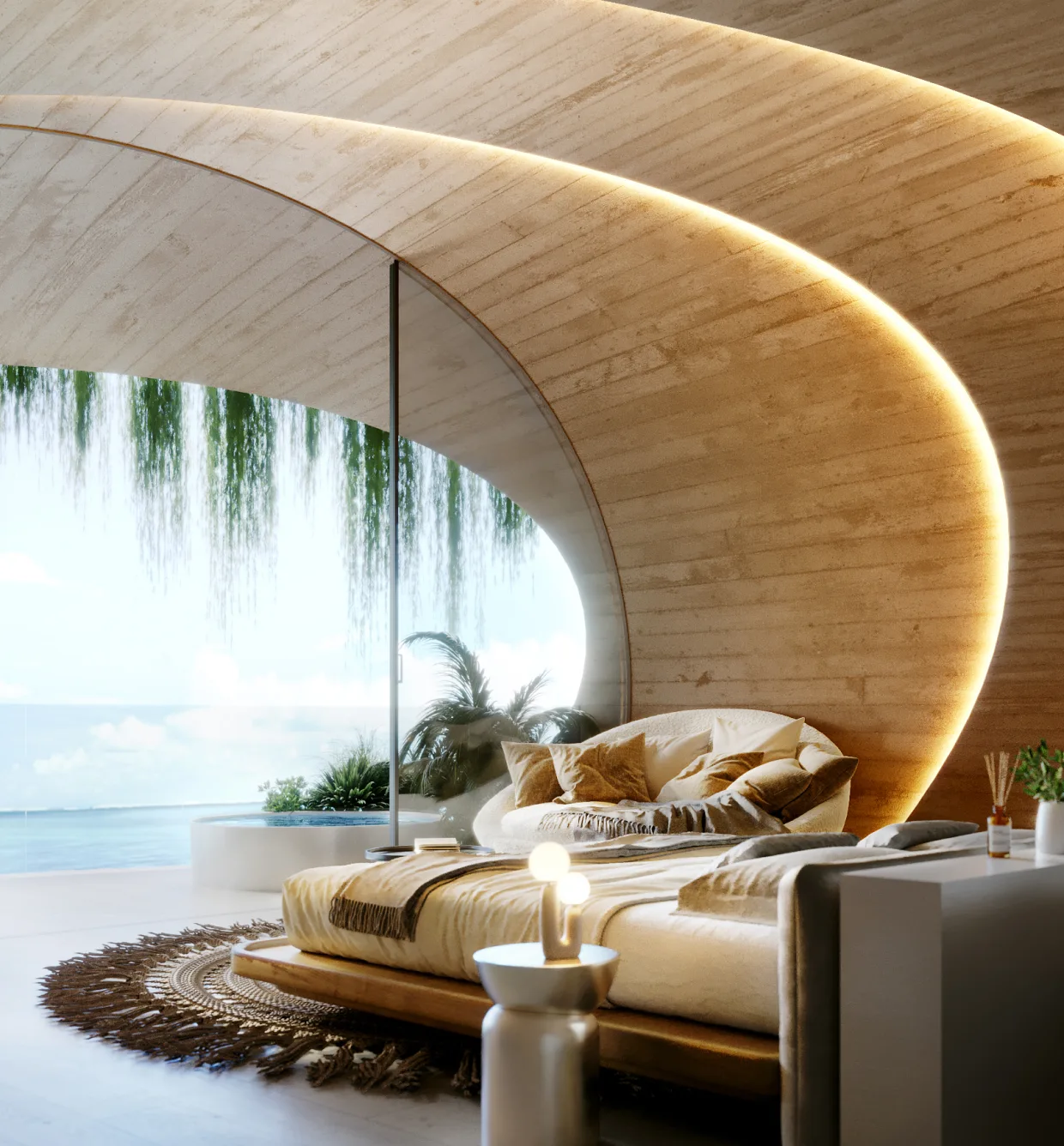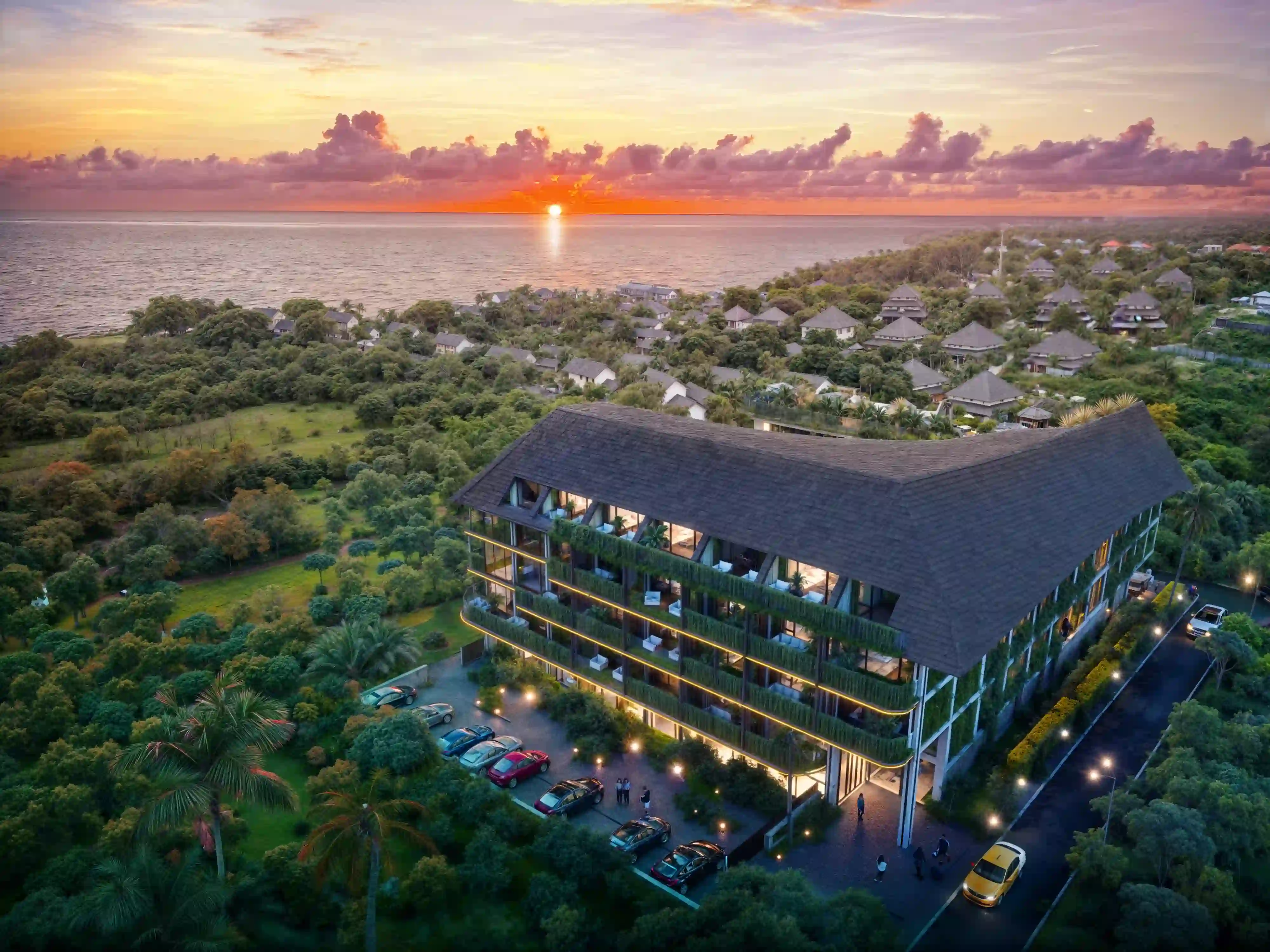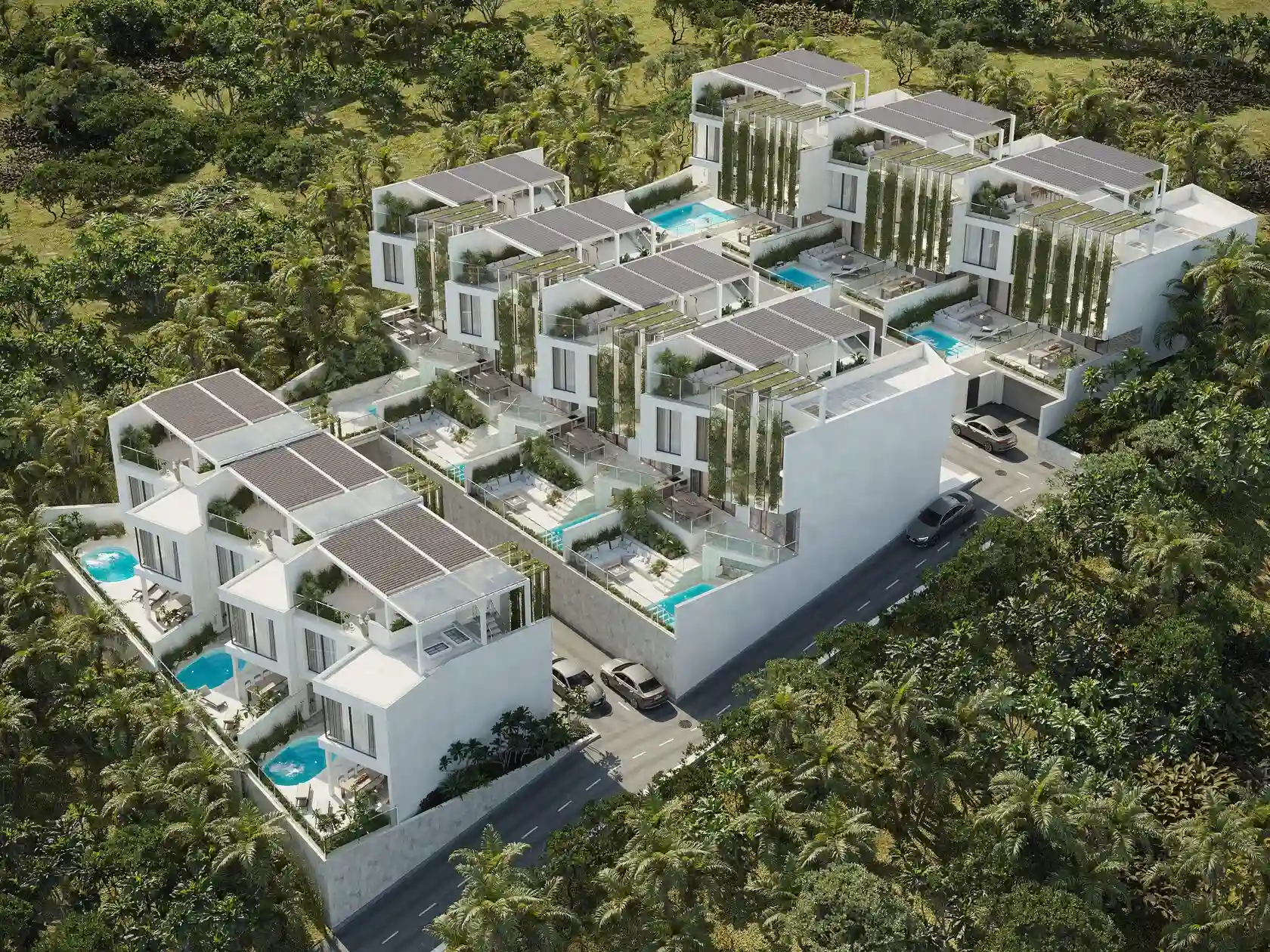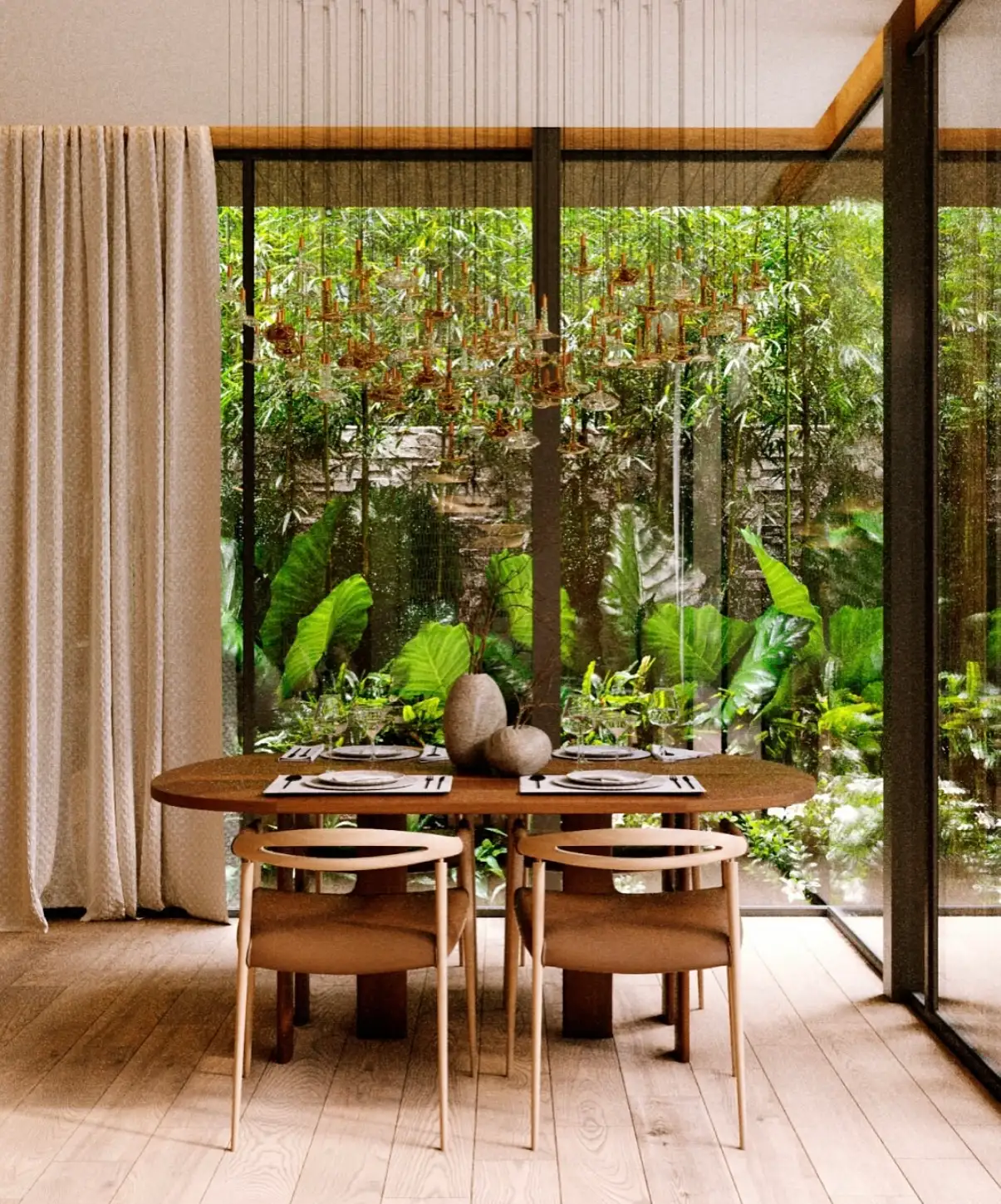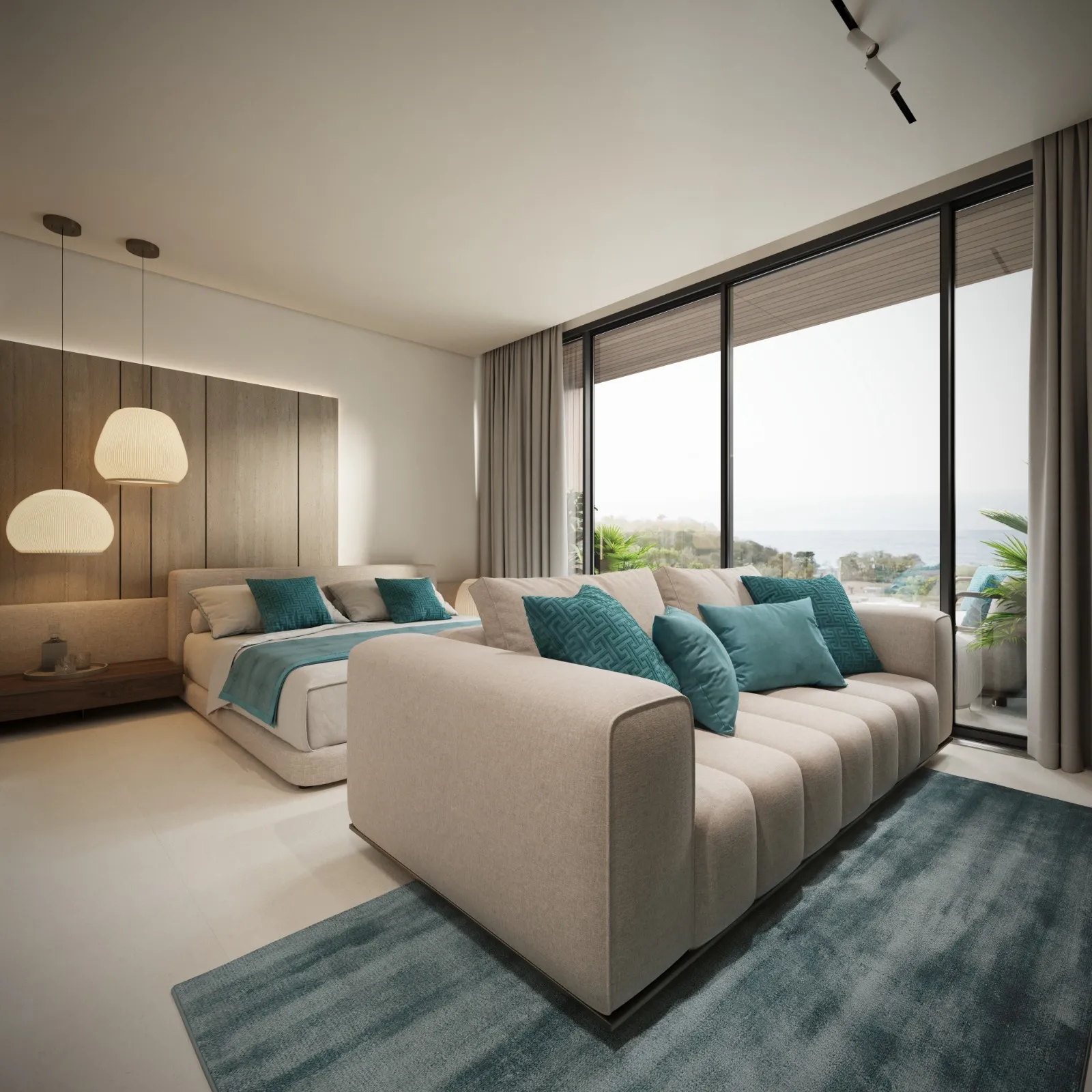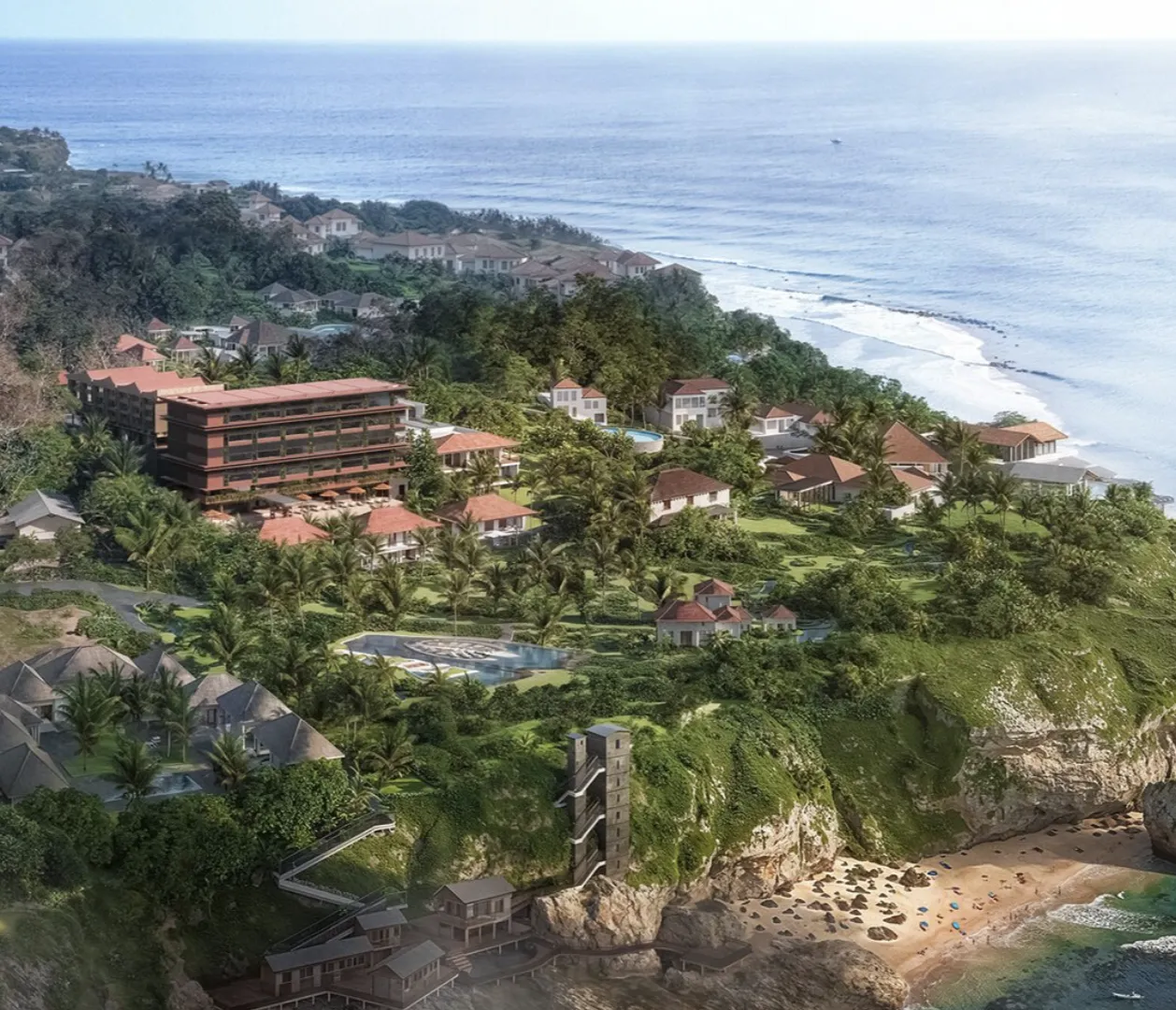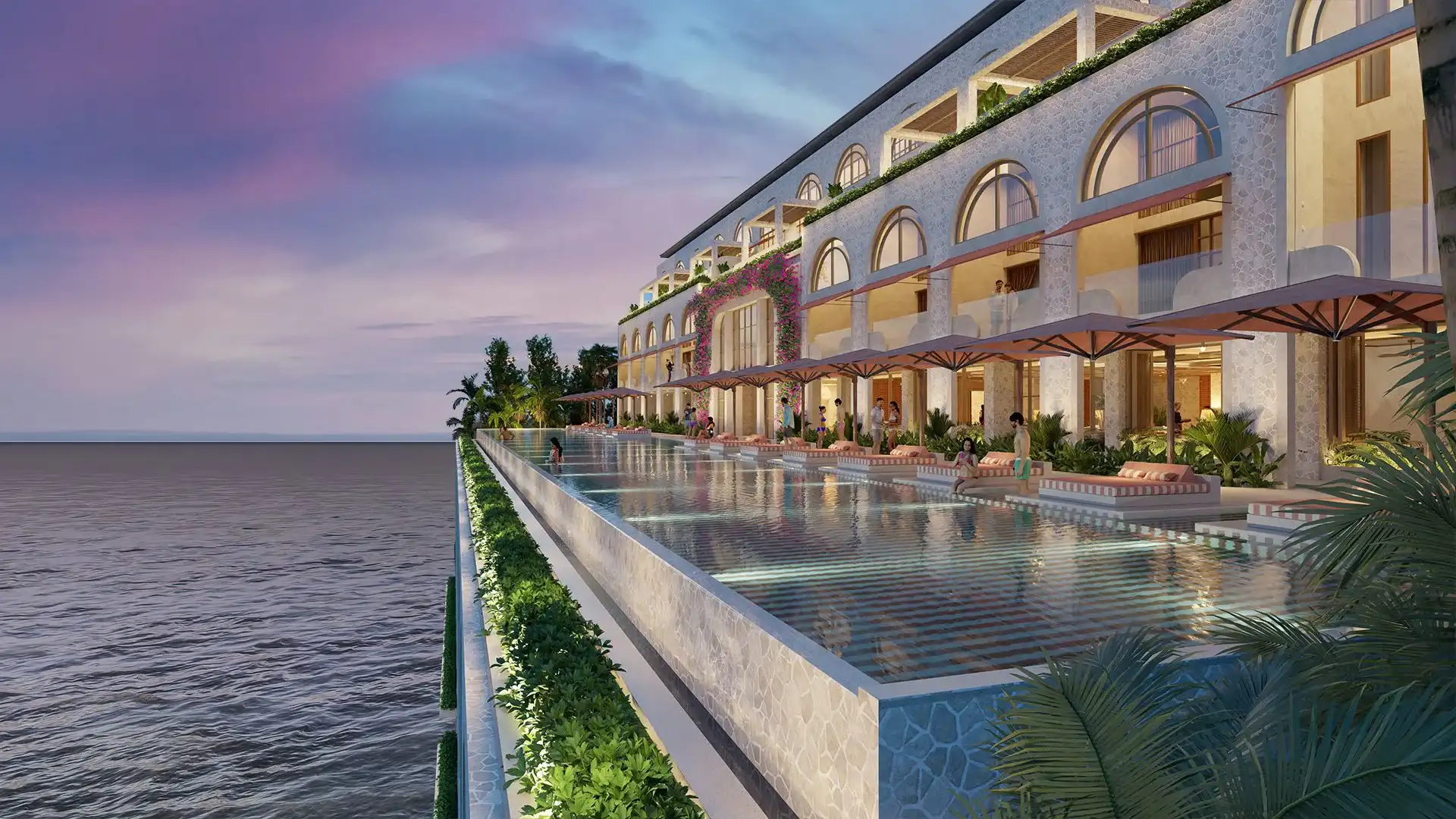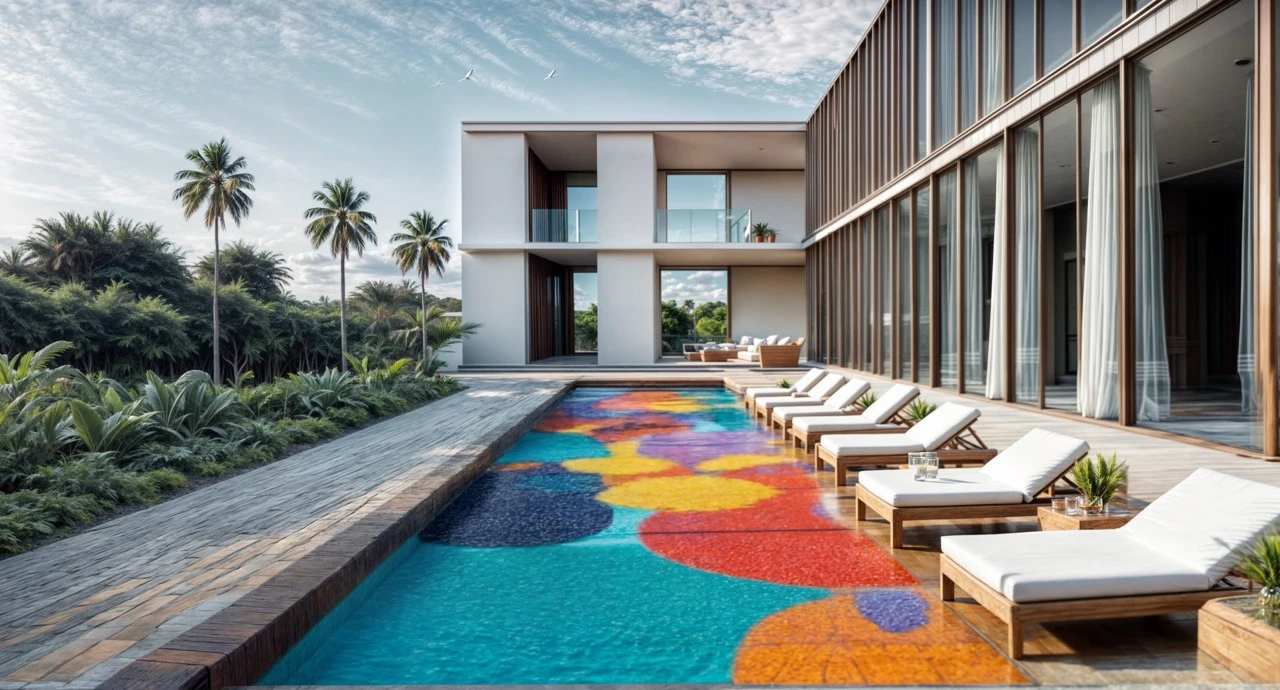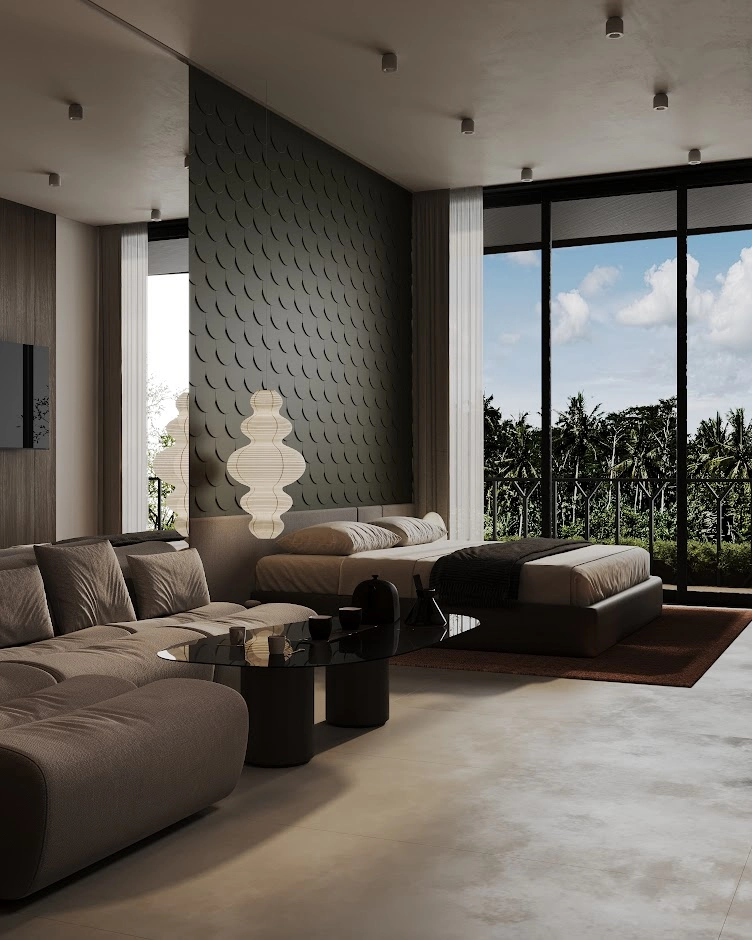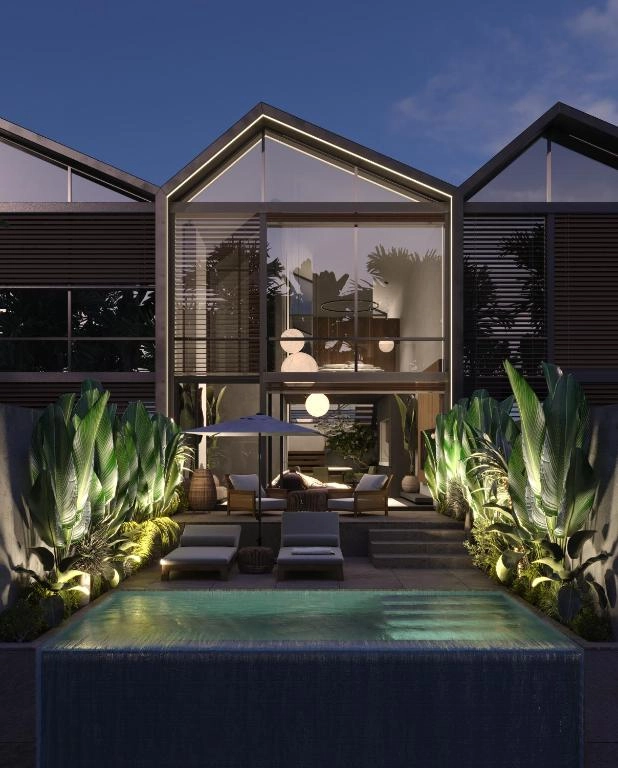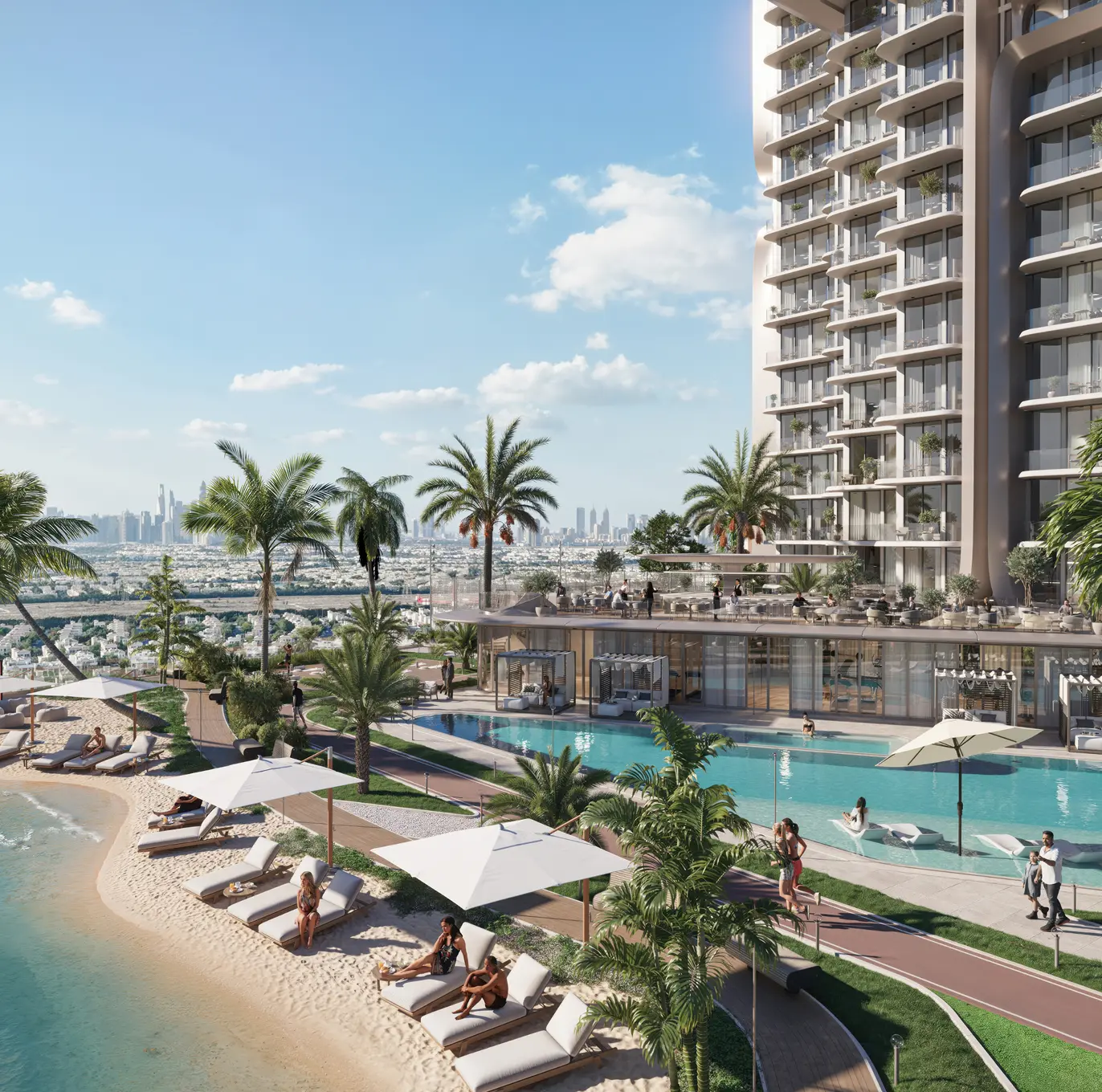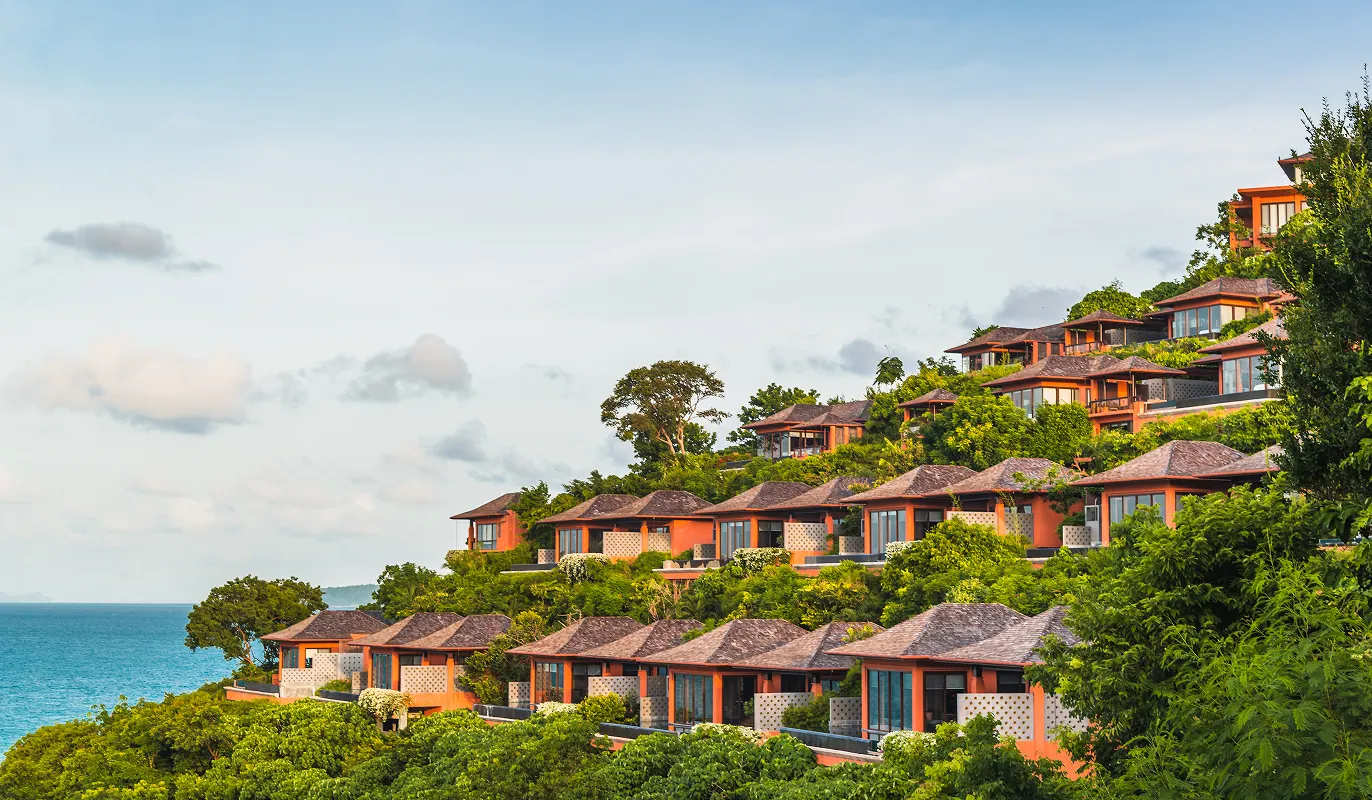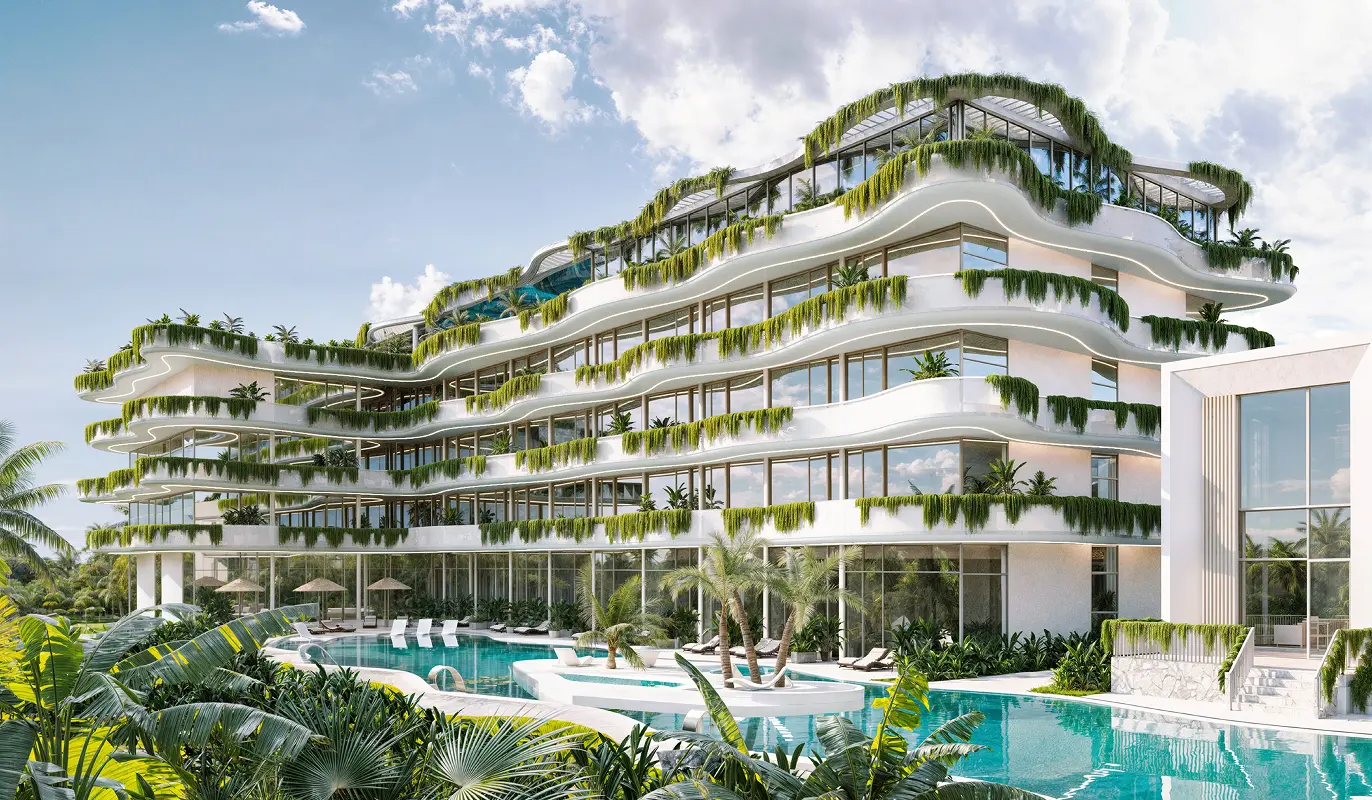Bali investment property in 2025: the best areas for living and returns
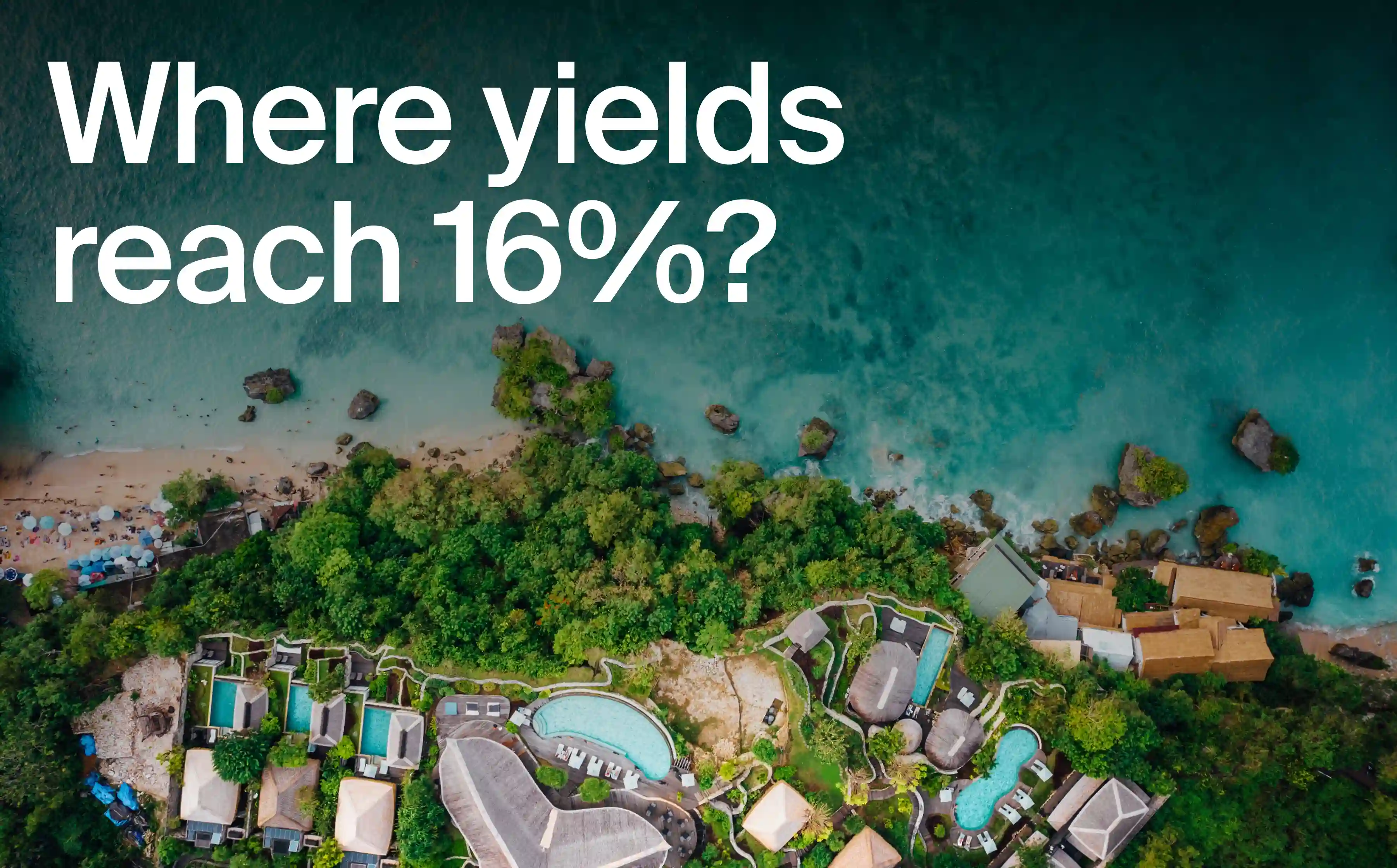

Dmitry Tsvetkov
Teamlead
Bali real estate offers investors impressive returns, with rental yields reaching 16% annually and resale profits hitting 40% in prime locations. However, these investment opportunities are not evenly distributed.
The island has transformed into a dynamic hub where each area offers a distinct investment profile — from the luxury-driven property in Seminyak to the wellness-focused community in Ubud. Understanding these differences is key to a successful property investment in Bali.
This guide breaks down the 10 best areas to invest in, analyzing the real estate market dynamics, pricing, and unique appeal of each area for those looking to invest in Bali real estate. Whether you're seeking villas for sale or exploring areas to buy rental properties, we'll help you identify the top areas that offer the best investment potential in Bali real estate in 2025.
$80,000
Entry threshold for the Bali market
$2,500–3,500
Average price per m² in the primary market
8–16% per year
Net rental yields
Where to buy property in Bali: top locations and market performance
Bali's real estate market has transformed from a quiet tropical destination into one of Southeast Asia’s most active investment hubs over the past decade. Today, the island attracts both seasoned investors and first-time buyers looking to invest in Bali with strong growth and steady returns.
According to Neginski’s analysts, property prices in Bali’s prime locations often grow by 10–20% during construction and by another 5–10% after completion. On the rental side, buyers can expect net return on investment — already calculated after all expenses — of 10 to 16% annually for vacation rentals and 8 to 12% for long-term leases, making it an excellent investment opportunity.
The most promising investment areas are concentrated in South Bali, where tourism, infrastructure projects, and expatriate communities create the strongest conditions for rising property values and high rental income. These popular areas to buy property offer diverse investment strategies for those seeking to invest in Bali real estate.
Top 10 locations to buy property in Bali
Canggu — Trendy surf town and digital nomad hub with beach clubs and a lively social scene.
Seminyak — Upscale district with luxury resorts, fine dining, and designer shopping.
Bukit — Cliffside peninsula with secluded beaches and world-class surf.
Ubud — Bali’s cultural and spiritual center, surrounded by rice fields and rainforest.
Nuanu — Innovative new community focused on sustainability and creative industries.
Seseh — Quiet coastal village with rice paddies and a relaxed atmosphere.
Cemagi — Peaceful area with black sand beaches and oceanfront villas.
Umalas — Family-friendly neighborhood between Seminyak and Canggu.
Kuta — Bali’s original tourist hub, famous for nightlife and surf schools.
Sanur — Laid-back seaside town with calm waters and a family-friendly vibe.
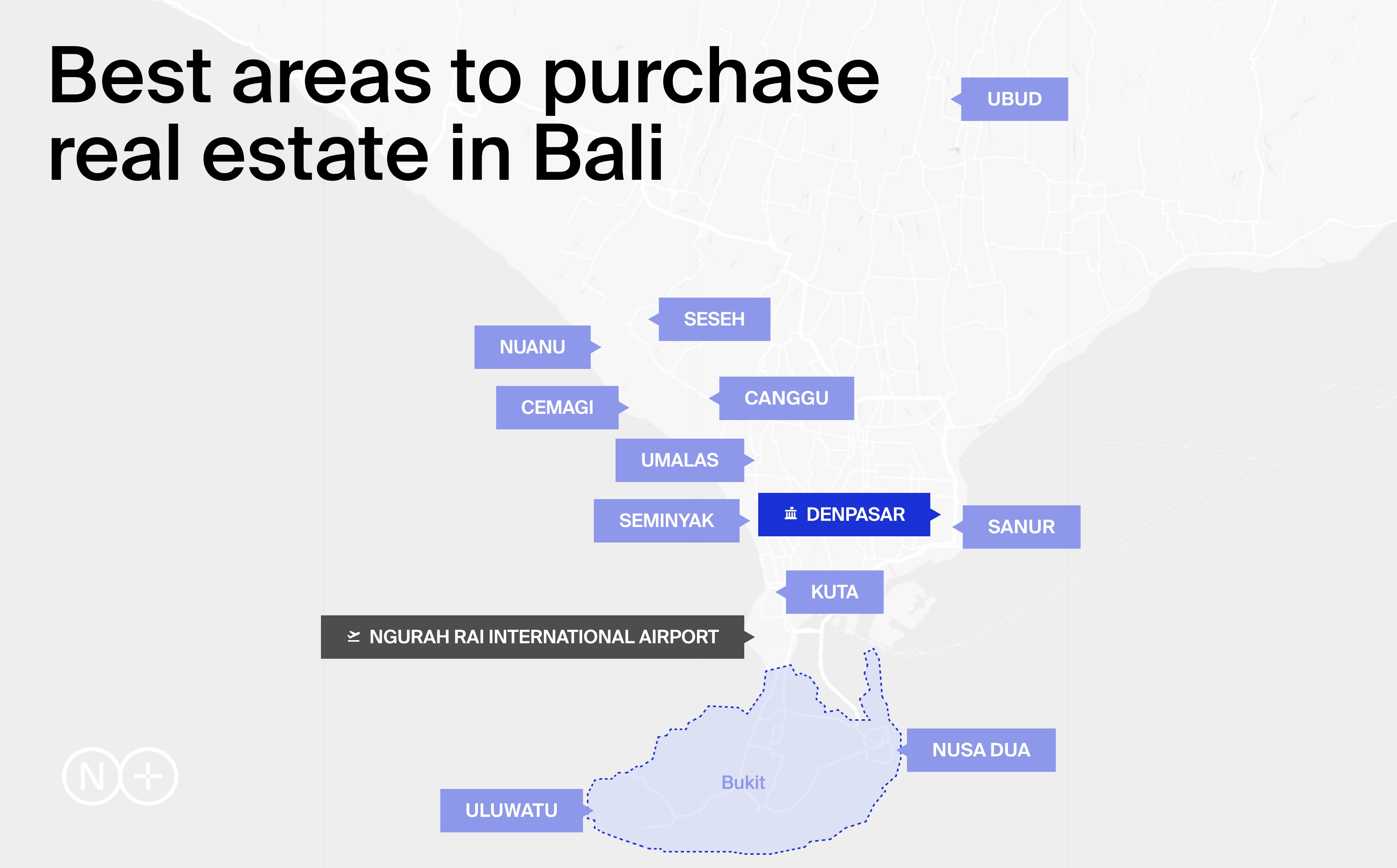
Canggu: the surfer’s paradise and digital nomad hub
If you’re looking for a place where beach life, surfing, and co-working blend into one, Canggu is the spot. In just a decade, this former fishing village has transformed into one of Bali’s most international communities, attracting surfers, freelancers, and young entrepreneurs from around the world.
Atmosphere and community
Canggu is a mix of traditional Bali and modern living. Villas with pools stand next to temples, stylish beach clubs share the streets with local warungs — traditional eateries — and trendy international restaurants.
Canggu is ideal if you want to combine online work with an active social and fitness-oriented lifestyle. It’s not a quiet village and not a polished resort either — it’s vibrant, energetic, and sometimes chaotic. For some it’s paradise, for others too crowded, but one thing is certain: it’s never boring.
.webp)
Shady patio cafés like this in Canggu create a space where modern expat life meets Bali’s lush greenery, time slows down, and conversations last for hours
Infrastructure
Canggu is about 45–60 minutes from the airport, but in peak hours, the trip can take up to 90 minutes. Within the area, motorbikes are the most practical way to get around — traffic is heavy, but you’ll move faster than by car.
A light rail line is planned to connect Canggu with Denpasar, which should ease congestion in the future.
Attractions and activities
Canggu is best known for its beach clubs:
Finns Beach Club is the district’s landmark, with pools, DJs, and sunsets that turn into nightlife.
La Brisa, built from old fishing boats, serves organic food in a magical seaside setting.
Old Man’s is the wildest beach club, famous for its parties right on the sand in the heart of town.
For the outdoors, there’s plenty beyond the beach:
Echo Beach is a surfing icon with black volcanic sand and endless cafés.
Jiwa Garden is an eco-space offering workshops on sustainable farming.
Jungle Padel brings the fast-growing racket sport to Bali’s tropical greenery.
Breathwork Bali and numerous yoga studios offer ways to recharge the body and mind.
FINNS Recreation Club is one of the trendiest spots, with a water park, gym, and tennis courts attracting a fashionable crowd.
.webp)
Sunset vibes at a Canggu beach club. The coastline here faces west, which means nearly every evening ends with a front-row view of Bali’s famous fiery sunsets
Property market analysis
Overview. Canggu has a balanced property market where both villas and apartments are in strong demand:
Villas appeal to families, long-term residents, and those with higher budgets who value space and privacy.
Apartments, on the other hand, are the choice of digital nomads and young professionals who care more about vibe and convenience than creating a full “home atmosphere.”
This dual demand for rental properties keeps both segments equally active and competitive.
Prices. Current pricing reflects this demand. Standard properties are valued at $2,500–3,500 per m², rising to $6,000 per m² for premium locations. In the most desirable beachfront areas, especially for high-end villas, prices can reach $8,000 per m².
Entry-level prices start at $100,000–120,000 for apartments and $200,000–250,000 for villa properties.
Strong points. For investors, Canggu delivers reliable rental income and property value appreciation, but it’s no longer a bargain market. With most of this area of Bali already built up, new projects are scarce and priced at a premium. This exclusivity, combined with constant tourist demand, strong expat presence, and year-round occupancy, positions Canggu firmly as Bali’s lifestyle hub for those ready to pay top dollar.
Considerations. At the same time, density and congestion have become notable challenges. Traffic is one of the main drawbacks, and it impacts not only day-to-day convenience but also the overall desirability of certain properties. As a result, micro-location is critical.
Homes located on quieter streets within walking distance of the beach consistently command higher rental yields and enjoy stronger resale value compared to properties positioned near busy main roads.
Expert selection of properties to buy in Canggu
Seminyak: luxury, style and fine dining by the beach
If Canggu is Bali’s hip and energetic surf hub, then Seminyak is its polished older sibling. This is the island’s most stylish address — where designer boutiques meet golden beaches, and sunset cocktails are as much a ritual as surfing. Once a quiet stretch of coast, Seminyak has grown into Bali’s luxury playground without losing its relaxed, tropical vibe, making it one of the popular areas for those seeking to invest in real estate.
Atmosphere and community
Seminyak draws a cosmopolitan crowd: entrepreneurs, creatives, and travelers who prefer a glass of champagne to a Bintang beer. The vibe here is elegant but never snobby. Days are spent shopping at chic boutiques or relaxing at luxury spas, and evenings start with fine dining and end at one of Bali’s iconic beach clubs.
Seminyak is perfect if you want Bali’s beaches but with a touch of city style. It suits couples, groups of friends, and expats who enjoy dining out, shopping, and nightlife more than chasing waves.
If Canggu sometimes feels too young and chaotic, Seminyak offers a more refined lifestyle — tropical, but with all the comforts of an upscale destination, providing the best of both worlds for those considering owning a property here.
.webp)
Seminyak coastline is one of Bali’s most exclusive addresses
Infrastructure
One of Seminyak’s biggest perks is accessibility. The area sits just 30–40 minutes from Ngurah Rai International Airport — much closer than Canggu or Uluwatu. That said, traffic can be heavy, especially during the tourist season. Most people rely on taxis, ride-hailing apps, or private drivers.
In the coming years, new infrastructure is set to make life even easier: a railway line will connect the airport directly to Seminyak, while the recently launched water taxi service already links the harbor to beachfront hotels.
Attractions and activities
Seminyak’s beaches may not have the towering surf of Uluwatu, but they are perfect for both beginners and casual sun-seekers:
Seminyak Beach offers long sandy stretches.
Petitenget Beach is quieter and more laid-back.
Double Six Beach has a fun social vibe with bars and cafés right on the sand.
When the sun goes down, Seminyak comes alive:
Potato Head is a design icon and one of the world’s most famous beach clubs, known for its architecture, DJs, and sunset views.
KU DE TA set the standard for Bali’s luxury beach scene, with fine dining and ocean panoramas.
La Favela is a quirky late-night spot, packed with antiques and eclectic décor, where parties often run until dawn.
Red Ruby anchors the underground electronic music scene, combining terrace dining with a pulsing club atmosphere.
Foodies and shopaholics are equally spoiled in Seminyak. World-class chefs run restaurants serving everything from Japanese omakase to Mediterranean feasts, while Jalan Kayu Aya and Jalan Laksamana are lined with designer stores and local fashion brands. High-end spas complete the picture, offering everything from traditional Balinese massage to modern wellness treatments.
.webp)
Nasi tumpeng, with its signature cone of turmeric rice, is one of Bali’s most iconic festive dishes, usually shared during cultural celebrations
Property market analysis
Overview. Seminyak is one of Bali’s most established premium markets among areas in Bali, where prices are shaped by constant demand and limited land availability. The area is dominated by luxury villas and boutique developments, catering to buyers seeking exclusive beachfront or near-beach residences.
Prices. Pricing is among the highest on the island. Well-positioned properties sell for $4,500–6,500 per m², while prime assets in top beachfront locations can reach $10,000 per m².
Entry-level prices for villas start at $350,000. This makes Seminyak a more expensive entry point compared to emerging districts, but also one of the most secure from a value-retention perspective.
Strong points. For investors, Seminyak delivers reliable income streams thanks to its steady flow of high-end tourists and long-term expatriates. Occupancy in luxury rentals remains strong, and the district’s established reputation as a lifestyle destination continues to support both yields and capital appreciation. Future infrastructure improvements — including planned transport links — further strengthen its outlook.
Considerations. The main challenges lie in supply constraints and intensifying competition. With limited new land available, opportunities for large-scale projects are scarce, and Seminyak increasingly competes with other luxury markets such as Canggu and Bukit.
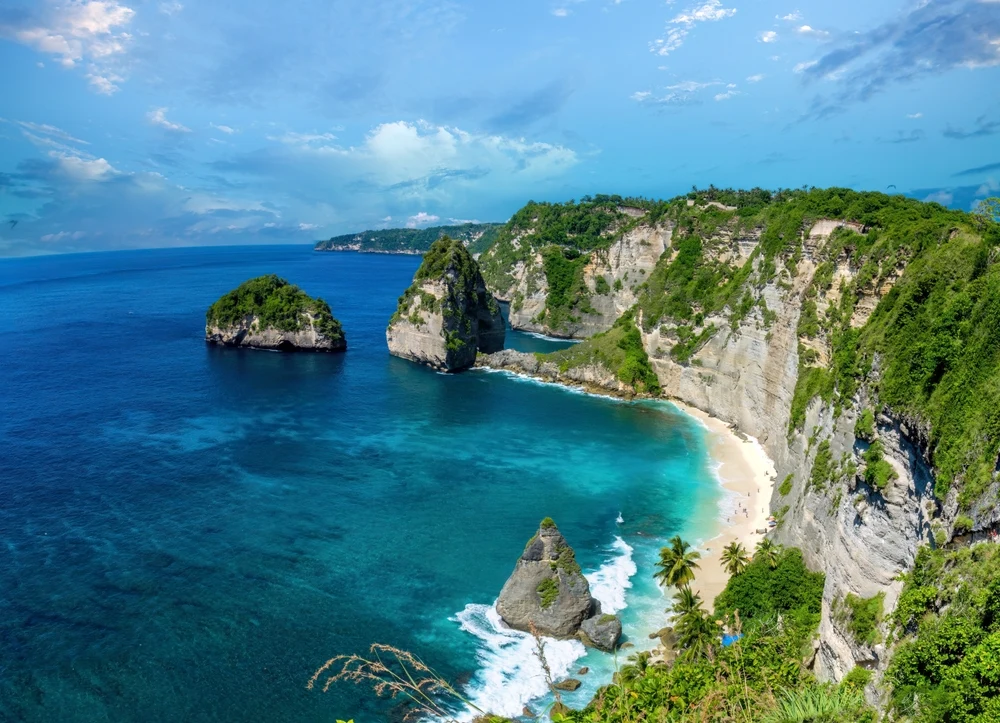
Know your returns before you invest
We’ll assess your goals and opportunities and run the numbers.
Bukit: cliffside views and world-class surfing
At Bali’s southern tip, the Bukit Peninsula is where dramatic cliffs meet turquoise waters and some of the best waves on the planet. It’s a place where luxury resorts overlook hidden beaches, seafood is served right on the sand, and surf culture is as alive as ever.
The area includes famous names like Uluwatu, Nusa Dua, and Jimbaran, each offering its own flavor of island life.
Atmosphere and community
Bukit has a split personality in the best way:
Uluwatu is the heart of surf culture, where pro surfers and backpackers share waves by day and beers by night. Cafés and clifftop bars buzz with energy, especially at sunset.
Nusa Dua, by contrast, feels like a world apart: a secure resort enclave with manicured beaches, five-star hotels, and a family-friendly atmosphere. It attracts travelers and expats who want comfort and convenience with everything at their doorstep.
Jimbaran is still keeping its roots as a fishing village. The bay is lined with seafood restaurants where you can eat freshly grilled fish with your feet in the sand while the sky turns gold at sunset.
Bukit is perfect for those who want a balance of adventure and luxury. Surfers will be in heaven, families can enjoy Nusa Dua’s calm and comfort, while couples will fall for the romantic sunsets of Jimbaran. It’s less crowded than areas like Canggu, but with no shortage of world-class amenities — making it one of Bali’s most versatile destinations and an exceptional investment opportunity.
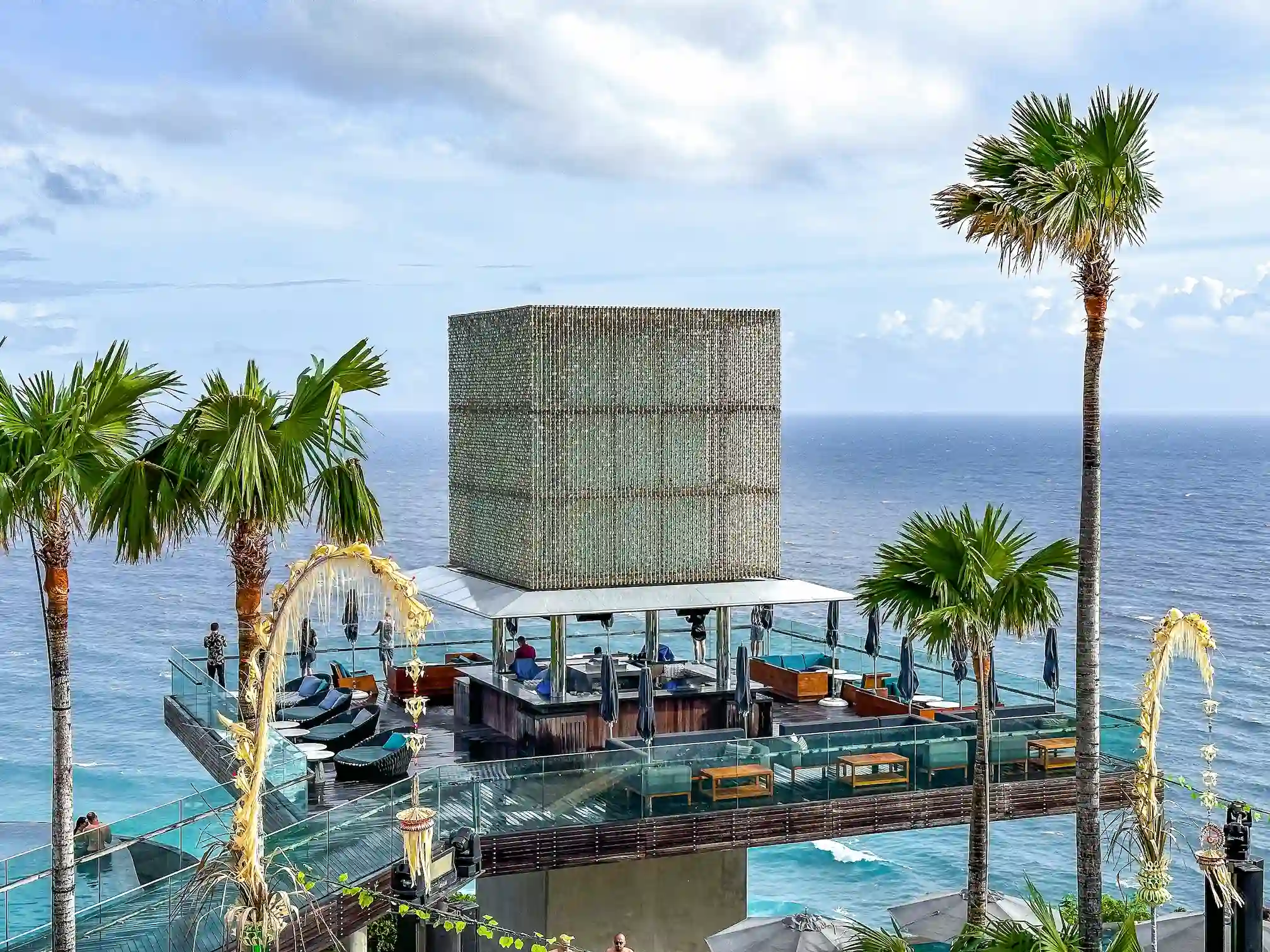
Clifftop beach clubs in Uluwatu is where world-class DJs, infinity pools, and panoramic ocean views create some of Bali’s most memorable nights
Infrastructure
The Bukit Peninsula is just 15–30 minutes from Ngurah Rai International Airport, making it one of the easiest luxury escapes to reach. Well-maintained roads connect the main areas, though traffic can be heavy in the high season. To help, a new West Ring Road is under construction, designed to ease congestion around Jimbaran and give travelers alternative routes.
Healthcare here is solid too, with modern clinics like BIMC Nusa Dua Hospital serving residents and visitors.
Attractions and activities
Bukit is legendary among surfers, with breaks to suit every level:
Uluwatu is the crown jewel, offering powerful swells across five distinct sections.
Padang Padang is world-famous for perfect barrels when the swell is big.
Bingin and Impossibles are fast reef breaks for experienced riders.
Dreamland is more forgiving, making it ideal for intermediates.
Green Bowl, Pandawa, and Nusa Dua on the east coast deliver a variety depending on tides and season.
The social life here often takes place high on the cliffs or right by the water:
Savaya Bali is famous for its clifftop stage, international DJs, and unforgettable sunsets.
Single Fin is an Uluwatu institution, mixing surf vibes with stylish sunset parties.
Omnia and Ulu Cliff House push the luxury club scene, offering VIP experiences and global performers.
Sundays Beach Club takes things slower, with a private lagoon, family-friendly dining, and water sports.
It’s not all about beaches:
New Kuta Golf Course offers dramatic ocean views from the fairways.
The Garuda Wisnu Kencana cultural park hosts monumental statues and cultural shows.
The Pura Luhur Uluwatu temple, perched on a cliff, is one of Bali’s most iconic sites, especially during the traditional Kecak dance at sunset.
Bali Collection brings curated shopping and dining in Nusa Dua, while luxury resorts like the Hilton and The Ungasan offer infinity pools, spas, and fine dining.
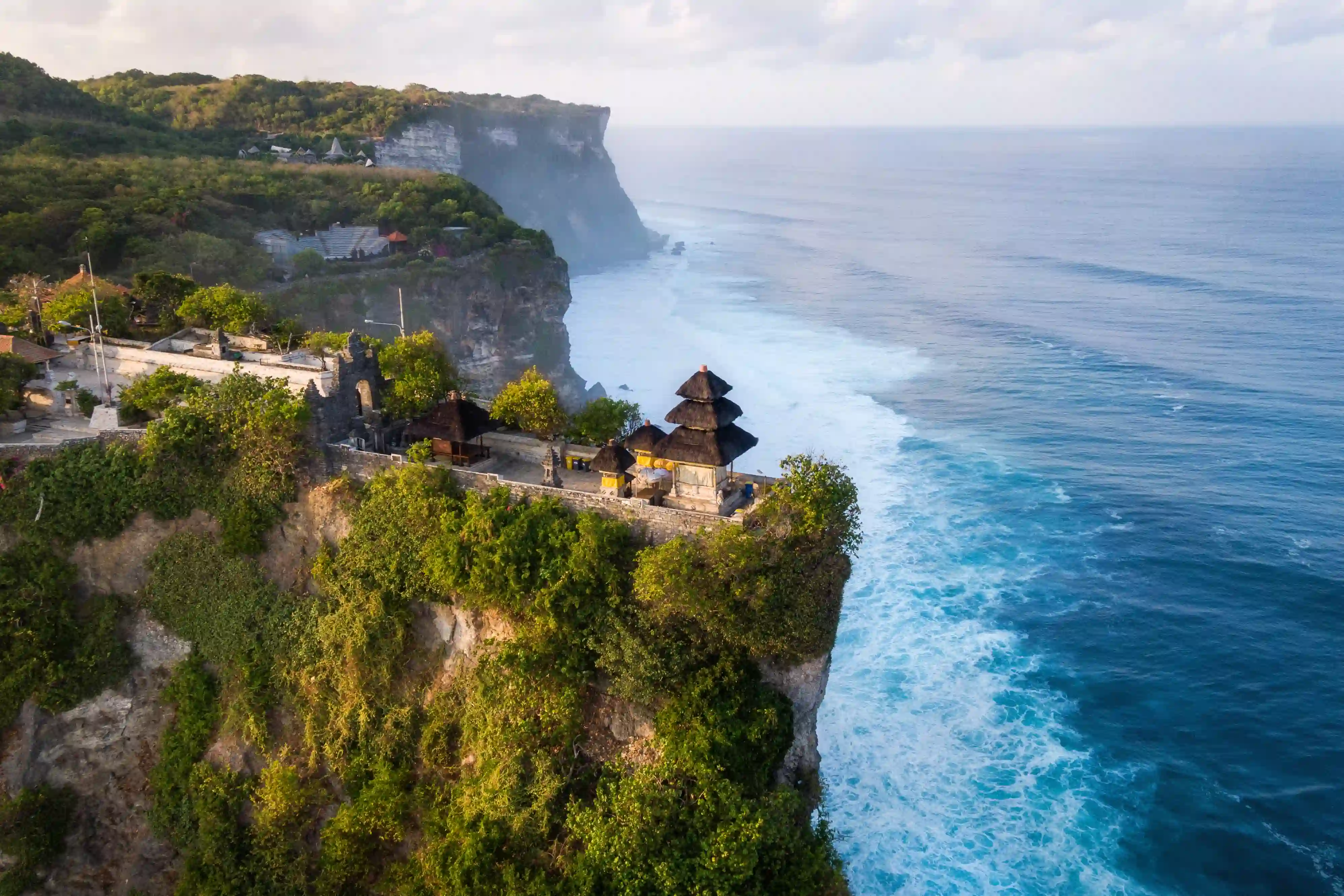
Pura Luhur Uluwatu, overlooking the Indian Ocean from Bukit’s cliffs, is not only a cultural landmark but also a magnet that drives year-round tourism to the peninsula
Property market analysis
Overview. The Bukit Peninsula has become one of Bali’s most dynamic markets, driven by sustained demand for high-end apartment complexes and luxury villas in Bali. Its appeal lies in dramatic ocean views, resort-style amenities, and a lifestyle that blends exclusivity with tropical seclusion.
Prices. Pricing is broadly comparable to Canggu, with most properties valued between $2,500 and $5,000 per m².
Entry-level prices start at $90,000 for apartments and $100,000 for compact villas. The lower entry point reflects both Bukit’s distance from the island’s center and areas where infrastructure is still developing.
Strong points. Rental performance is one of Bukit’s key strengths. Average occupancy rates stand at around 85%, with annual yields in the 12–17% range, providing consistent rental income. Capital appreciation has also been notable, with resale profits of 15–40% achievable for well-located assets. The combination of year-round tourism, world-class surf destinations, and luxury hospitality underpins long-term demand.
Unlike more saturated markets, Bukit still offers land availability for new projects. This allows for greater diversity of investment options — from boutique villas and private estates to contemporary apartment complexes with ocean views. For developers and early movers, this creates opportunities that are no longer feasible in districts like Seminyak or central Canggu.
Considerations. Challenges remain: infrastructure improvements are ongoing, and parts of the peninsula continue to face seasonal traffic congestion. As in other premium markets, micro-location is decisive: cliffside villas and beachfront properties consistently outperform, delivering both higher rental yields and stronger capital growth compared to inland alternatives.
Expert selection of properties to buy in Bukit
Ubud: the cultural and spiritual heart of Bali
Tucked away in Bali’s central foothills, surrounded by rice paddies and jungle ravines, Ubud feels a world apart from the island’s busy surf towns. It’s quieter here, more mindful, and deeply rooted in creativity and tradition. For many visitors and expats, Ubud is where you go when you want to slow down, recharge, and connect with the cultural side of Bali.
Atmosphere and community
Ubud is the meeting point of Balinese tradition and global wellness culture. On one street, you’ll find family-run galleries, weaving studios, and woodcarving workshops. On the next, you’ll pass yoga shalas, meditation retreats, and juice bars full of travelers comparing their latest detox program.
Traditional temple ceremonies and festivals are part of daily life, yet so are digital nomad meetups and yoga teacher trainings.
Ubud is for travelers and expats who want more than beaches and nightlife. It’s the right choice if you’re drawn to yoga, meditation, healthy food, or simply a slower pace surrounded by nature. Families, creatives, and digital nomads all find a sense of belonging here, while visitors looking for the “real Bali” rarely leave disappointed.
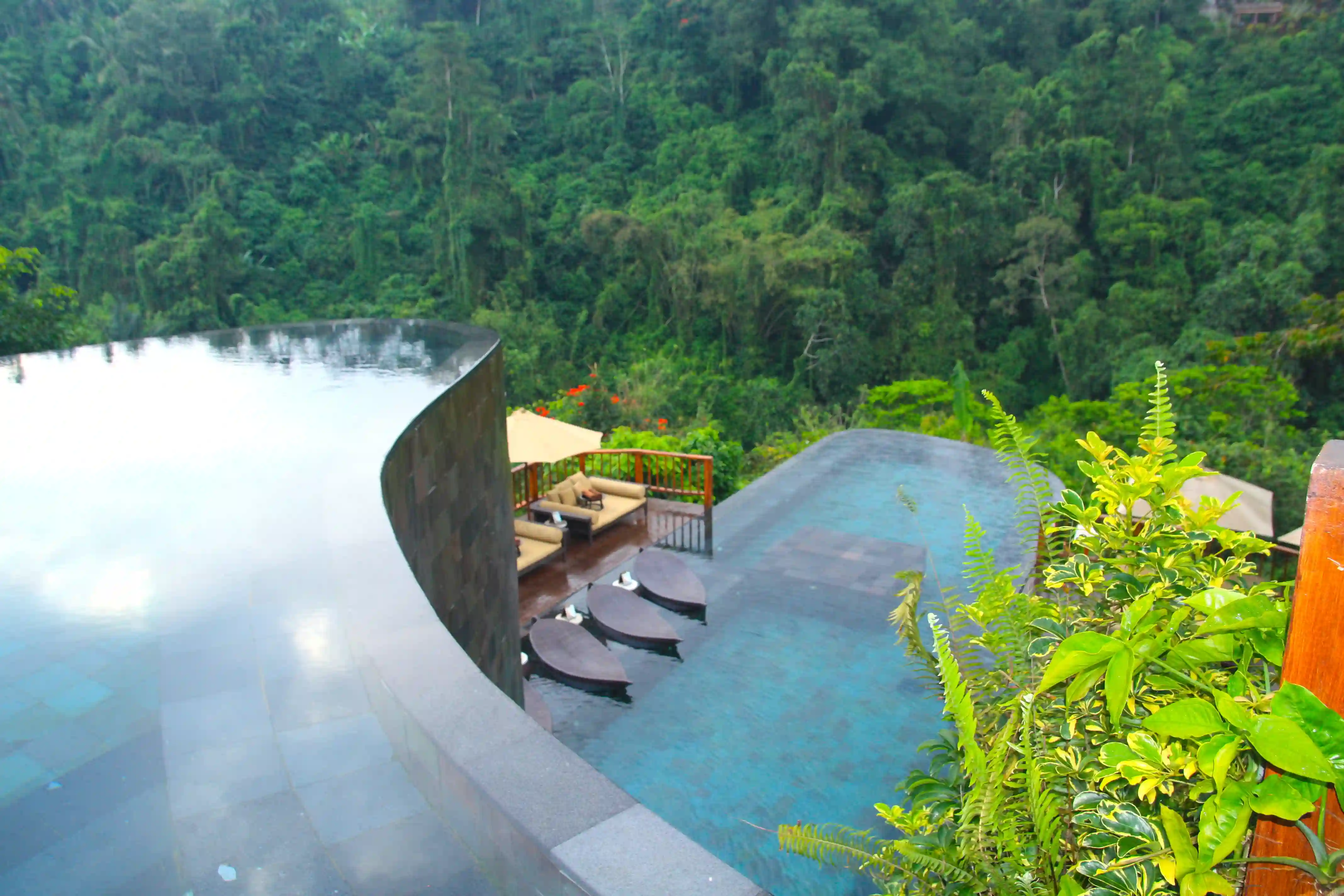
Resorts and villas in Ubud often feature jungle-facing infinity pools is a hallmark of the area’s wellness lifestyle
Infrastructure
Reaching Ubud takes about an hour from the airport, and while traffic into town can be busy, road-widening projects are slowly improving things. Its central location makes it a great base for exploring the rest of Bali, especially the island’s northern regions and interior.
For families, Ubud is one of the best spots outside the coast. The famous Green School offers world-class education in a jungle setting, while Pelangi School and numerous kindergartens provide options for younger children.
Digital nomads aren’t left out either: with high-speed internet and co-working hubs like Hubud and Outpost, Ubud has become one of Asia’s top remote-working destinations.
Attractions and activities
Ubud is filled with historic sites and cultural gems that reflect its role as Bali’s artistic and spiritual heart:
Saraswati Temple and Gunung Lebah Temple showcase the beauty of Balinese architecture and spirituality.
Ubud Palace hosts traditional dance performances in the evenings.
The Sacred Monkey Forest Sanctuary combines temple ruins with curious macaques wandering through the jungle.
The Antonio Blanco Museum highlights the works of the eccentric artist who called Ubud home.
Ubud is Bali’s wellness capital:
Organic cafés like Zest serve farm-to-table dishes.
Yoga studios run classes from sunrise to sunset.
Spas range from simple Balinese massage spots to luxury wellness retreats.
Beyond the town, nature is everywhere:
The Tegallalang Rice Terraces are one of Bali’s most iconic sights, with their layered green hillsides.
Trails lead to waterfalls and rivers hidden in the jungle, and cycling routes wind through rice fields and traditional villages — offering a glimpse of Bali at its most authentic.

Morning light over the Tegallalang rice terraces is one of Bali’s most photographed landscapes and a must-see near Ubud
Property market analysis
Overview. Ubud offers a very different market profile compared to coastal areas like Canggu and Uluwatu. Around 100,000 visitors each month come to Ubud, many of them staying for weeks or months to join retreats, wellness programs, or remote work residencies, creating high demand for rental properties.
Prices. Property prices here average $2,500–4,000 per m², which is lower than in beachside districts, yet demand is supported by the area’s reputation as the island’s cultural and wellness capital.
Entry-level prices start at $105,000 for apartments and $210,000 for villas.
Strong points. For investors, Ubud is one of Bali’s most reliable rental markets. Occupancy rates average 75–80% year-round, significantly less seasonal than coastal zones, and annual yields can reach up to 15%.
Rental prices vary widely — from about $500 per month for long-stay digital nomads to more than $5,000 per month for luxury villas used for retreats. This diversity creates opportunities across both the mid-range and high-end segments.
Another strength of Ubud is its strict zoning regulations, which keep development density low. With fewer competing projects, existing properties maintain stronger rental performance and benefit from consistent price appreciation.
Expert selection of properties to buy in Ubud
Nuanu: the sustainable city of the future
Nuanu is not just another Bali neighborhood — it’s a bold experiment in sustainable living. Spread across 44 hectares between Nyanyi Beach and Tanah Lot Temple, it is Indonesia’s largest eco-focused development. The idea here is simple but ambitious: combine art, nature, and technology to show how the cities of tomorrow could look.
Atmosphere and community
Life in Nuanu feels experimental and creative. Artists, entrepreneurs, and tech innovators from all over the world come here to collaborate, share ideas, and build projects that mix innovation with responsibility.
70% of the land is kept green, filled with art installations, gardens, and natural spaces. Bamboo architecture rises next to digital art labs, while butterfly breeding programs flourish beside tech hubs. Balinese philosophy of harmony flows through everything, giving this futuristic city a spiritual grounding.
Nuanu is for pioneers — people who want to be part of something new and meaningful. It appeals to creatives, tech enthusiasts, and eco-conscious families who like the idea of living in a community that’s as much about the future as it is about Bali’s traditions.
.webp)
Boutique hotels like this illustrate Nuanu’s vision: combining eco-conscious design, premium amenities, and long-term investment appeal
Infrastructure
Nuanu is designed as a “living laboratory,” constantly testing and refining new systems for urban life. All vehicles are electric — from buses and golf carts to over 100 shared bicycles — saving nearly a ton of carbon emissions every day.
By 2027, Nuanu aims to be completely fossil-fuel-free. Despite its experimental nature, it remains well connected to Denpasar and the rest of Bali through main roads.
Just outside the development is the international ProEd Global School, while inside Nuanu an entire educational district is being built among 15,000 newly planted trees. Programs focus on sustainability, creativity, and innovation, making it one of the most forward-thinking learning environments in Bali.
Attractions and amenities
Nuanu is like a living art gallery, already home to over 30 creative projects:
Tri Hita Karana Tower is the landmark of the city, built from recycled timber to symbolize balance between people, nature, and the divine.
Aurora Media Park hosts performances and immersive shows where technology meets traditional art.
Earth Sentinel, or the Guardian of Nuanu, transforms the landscape with large-scale projection mapping.
Installations by artists like Daniel Popper and Alexander Milov create striking, photo-worthy moments throughout the community.
The city gives equal space to nature and well-being:
The alpaca farm and zoo provides family-friendly encounters in a sustainable setting.
The butterfly breeding program has boosted survival rates from 2 to 20%.
The 5-kilometer eco-trail allows for safe evening walks through the landscape.
Nyanyi Beach offers black sand, good waves for surfing, and unforgettable sunsets.
With over 30 restaurants, cafés, and event spaces, Nuanu’s dining scene is already buzzing. Luna Beach Club combines fine dining with beachfront entertainment. Restaurants range from traditional Balinese kitchens to international cuisine. A traditional longhouse serves as a unique venue for cultural gatherings and private events.
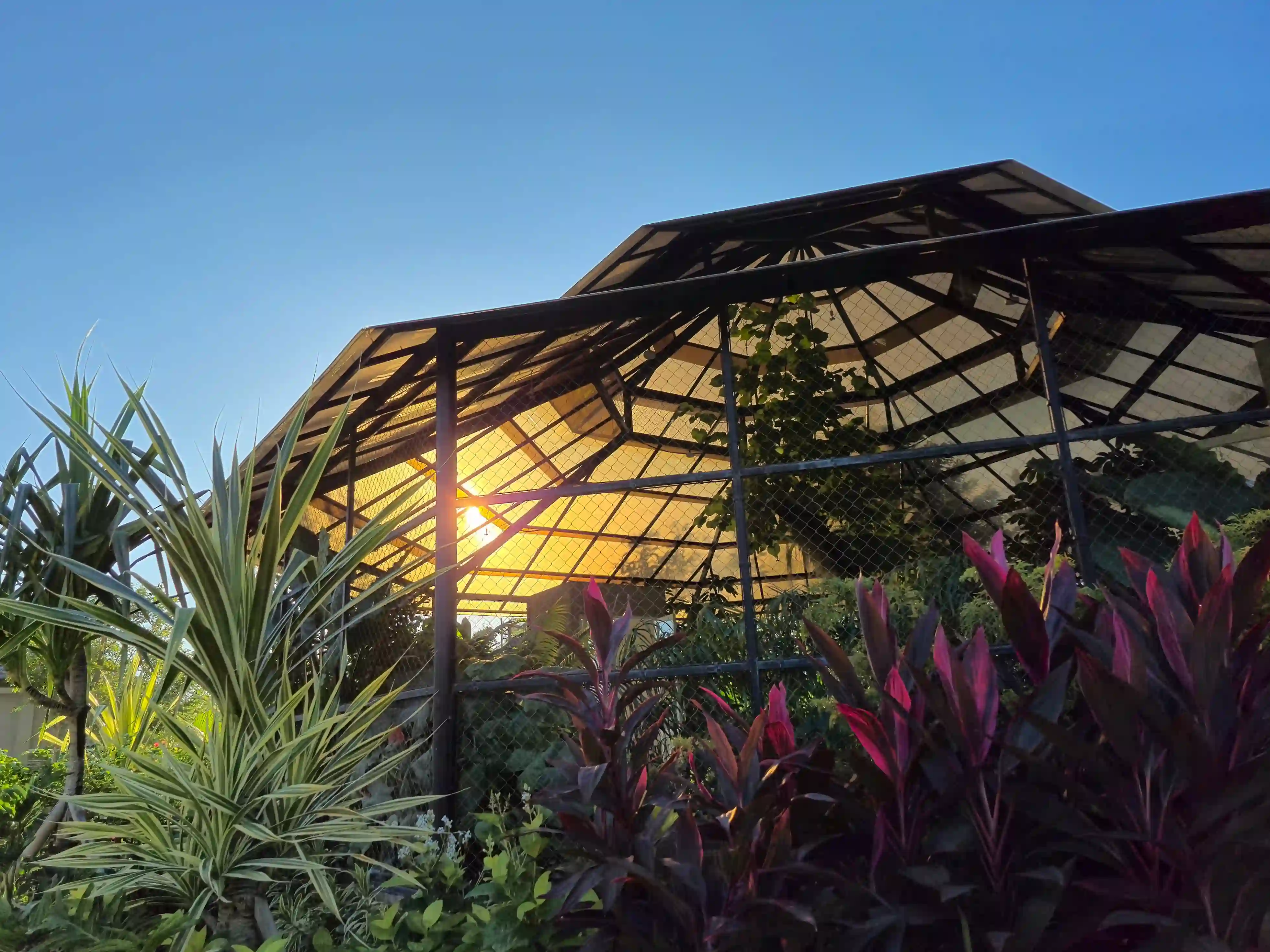
Greenhouse at Nuanu’s Magic Garden is a sanctuary of biodiversity where visitors can explore sustainable farming and conservation projects
Property market analysis
Overview. Nuanu is positioning itself as Bali’s hub for sustainable luxury living. Homes here are designed to combine premium comfort with environmental responsibility, making the district stand out from more traditional markets.
Prices. Property prices currently range from $2,800 to $4,500 per m², which is competitive compared to popular areas like Canggu or Seminyak, while offering investors the advantage of entering early into a large-scale master development.
Entry-level prices start at $100–150,000 for apartments and $300,000 for villas.
Strong points. The project is already drawing attention, with about 2,500 visitors daily and numbers rising by 10–15% each month. By the end of 2025, more than 3 million visitors are expected annually, creating strong demand for short-term rentals.
The development also benefits from a clear sustainability agenda: a shift to 100% renewable energy by 2027 and an ongoing $70 million investment program provide a strong foundation for long-term value growth.
Considerations. At the same time, Nuanu is still in progress, with full completion expected within the next 3 to 5 years. This offers early investors lower entry prices and the opportunity to grow with the community, but it also requires patience and confidence in the project’s ambitious vision.
The future success of Nuanu will depend on delivering its sustainability goals and maintaining its appeal as a creative, eco-conscious hub. For real estate investment purposes, this area continues to represent an investment choice for forward-thinking purchasers looking to buy villas and apartments in one of Bali's most innovative developments.
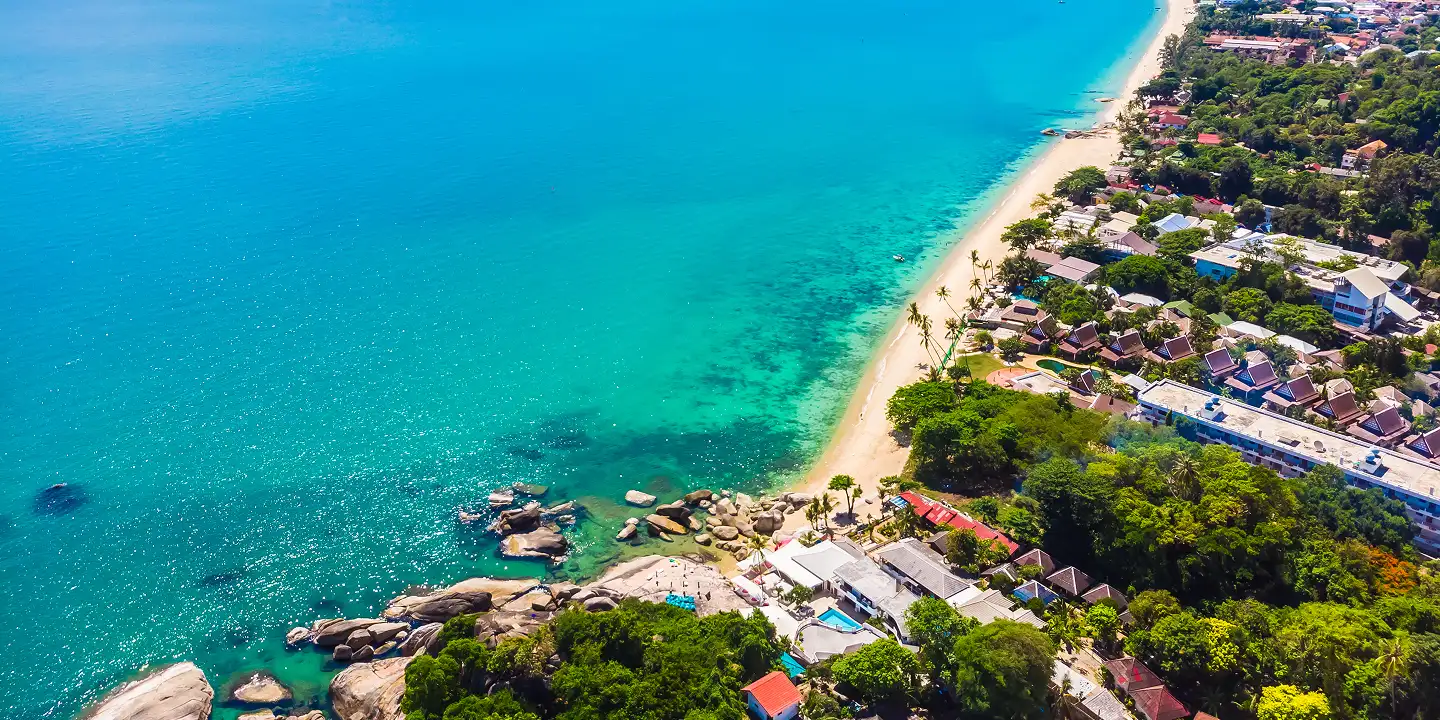
Need help finding the right property?
We vet every developer for track record, financial strength, and buyer feedback so only secure, high‑potential options make the cut.
5 more promising areas for Bali property investment
Beyond well-known hotspots like Canggu and Seminyak, Bali offers a range of districts that balance lifestyle appeal with strong investment potential. From tranquil coastal enclaves to vibrant tourist hubs, each area attracts its own audience — families, retirees, digital nomads, or short-term visitors — shaping distinct property markets for those investing in Bali's property.
Seseh: tranquil charm by the rice paddies
On the southwest coast near Canggu, Seseh offers a relaxed atmosphere with ocean views and a growing number of boutique villas, small hotels, and cafés. It is quieter and more exclusive than its bustling neighbor, appealing to those who value privacy without giving up comfort.
The property market is dominated by premium villas, with prices between $3,000 and $4,200 per square meter.
Cemagi: black sand beaches and seclusion
Next to Seseh, Cemagi maintains a stronger sense of traditional Balinese life, with rice fields, temples, and unspoiled beaches shaping the landscape. It is ideal for buyers who want seclusion and authenticity, paired with luxury villa living. While the area offers fewer restaurants and nightlife options, its appeal lies in its peaceful character and panoramic views.
Prices are similar to Seseh, ranging from $3,000 to $4,200 per square meter, with appreciation potential as demand grows for quiet coastal living.

Natural landmarks like Mengening Beach highlight Cemagi’s unique appeal. A coastline defined by raw beauty and seclusion is ideal for those seeking privacy away from Bali’s busier resorts
Umalas: a quiet residential enclave
Positioned strategically between Bali’s busiest hubs, Seminyak and Canggu, Umalas is a calm and upscale residential area. It attracts expatriate families from Europe, America, and Japan who appreciate the privacy, safety, and central location. Unlike tourist-heavy districts, Umalas has little nightlife, and most visitors stay in enclosed villas.
Umalas is also home to ProEd Global School, an international school that follows global curricula.
Property values range from $2,000 to $4,000 per square meter, making it a practical choice for those seeking a peaceful home base.
Kuta: Bali’s original tourist hub
Kuta was Bali’s first international tourist center and remains one of its busiest, with a wide beach, surf schools, waterparks, and an active nightlife scene. Its location next to the airport makes it especially convenient for visitors from Australia and Europe.
The property market is built around hotels and apartments, as villas are rare due to high-density construction. Prices range from $2,500 to $3,500 per square meter, making it an affordable entry point for purchasing property, though competition is high and the market caters mostly to short-term tourism and commercial properties.

Nightlife on Kuta Beach — bars and beanbags on the sand create a lively, casual atmosphere that keeps the area buzzing after dark
Sanur: laid-back coastal living
On the southeast coast, Sanur is known for its calm pace, attracting families and retirees who prefer a quieter lifestyle. Its beaches are less polished than those in Nusa Dua, with coral and seaweed, but the lower cost of living makes it appealing for long stays.
The district’s profile has risen with the opening of ICON Mall, Bali’s largest shopping center, and ANUR Harbour, a modern marina that offers direct connections to the Gili Islands, Lombok, and Nusa Penida.
Property prices here range from $3,000 to $4,000 per square meter.

Dmitry Tsvetkov
Teamlead
Is Denpasar, Bali’s capital, a good location to buy property on the island?
We don’t list Denpasar among the top buying locations because it’s primarily a local residential city, not a lifestyle or tourism hub. However, its role cannot be overstated. As Bali’s administrative and economic center, Denpasar is where land titles are registered, permits are processed, and infrastructure projects are planned.
The city drives everything from zoning regulations to airport expansion — factors that directly influence property values in Canggu, Seminyak, Bukit, Ubud, and beyond. In short, Denpasar is the engine behind Bali’s property market, even if the spotlight falls on the coastal and lifestyle markets.
Dmitry Tsvetkov
Teamlead
Bali property investment highlights
Bali’s real estate market offers diverse opportunities, but each location comes with its own strengths. For investors, the key to success is aligning their strategy — whether focused on capital growth, rental income, or lifestyle — with the right district.
The strongest fundamentals remain in South Bali, where tourism flows, infrastructure projects, and large expatriate communities sustain both price growth and rental demand.
For resale potential, the most attractive areas are Nuanu, Sanur, and the Bukit peninsula, which includes Nusa Dua and Uluwatu. Property values typically rise by 10–20% during construction and by a further 5–10% after completion.
For short-term rentals, markets such as Canggu, Seminyak, Ubud, and Kuta perform best, supported by Bali’s vibrant hospitality scene. Investors can expect net yields of 10–16% annually.
For long-term rentals, Ubud, Seminyak, and Umalas lead this segment, attracting expatriates and remote workers who prefer extended stays. Yields range from 8 to 12% per year.
For those seeking a home base rather than a pure investment, areas such as Umalas, Nuanu, Ubud, and Sanur provide a quieter pace, international schools, and strong community infrastructure.
In short, Bali combines lifestyle appeal with robust investment potential. The choice of location depends on whether the priority is capital appreciation, rental yields, or quality of life — but with the right strategy, the island continues to deliver.
FAQ
-
The strongest markets are in South Bali, including Canggu, Seminyak, Bukit with Uluwatu and Nusa Dua, as well as Sanur. Ubud and Nuanu also show high potential, especially for long-stay and wellness-driven rentals.
-
Short-term rentals can generate 10–16% annually, supported by over 6 million yearly visitors and strong demand from digital nomads. Long-term rentals are steadier, with 8–12% yields, driven by expatriates and families living in Bali year-round.
-
Foreigners cannot directly own freehold land in Bali, but they can invest legally through long-term leasehold, Hak Pakai — the right to use — or by establishing a PT PMA, which is a foreign-owned company. These structures provide secure, government-recognized rights to use or manage property for investment and residential purposes. For more details, read our full article on foreign property ownership in Bali.
-
Prices vary widely by location. Entry-level homes can start at around $2,000–2,500 per m², while prime areas like Seminyak or beachfront Canggu can reach $8,000–10,000 per m² for high-end villas.
-
Main challenges include traffic congestion in popular hubs, limited land supply in premium areas, and ongoing infrastructure development in emerging districts. Choosing the right micro-location is crucial, as proximity to the beach and quiet surroundings strongly influence both rental demand and resale value.
-
Umalas, Nuanu, and Sanur are the most family-friendly, offering a quieter pace, international schools, and strong community infrastructure. Ubud is also attractive for families seeking a nature-oriented lifestyle with access to schools like the Green School.
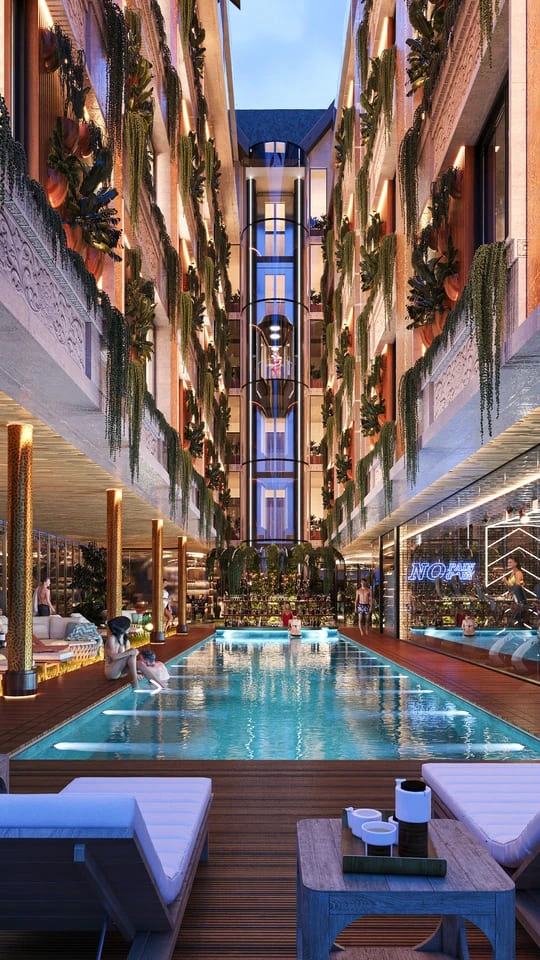
.webp)
